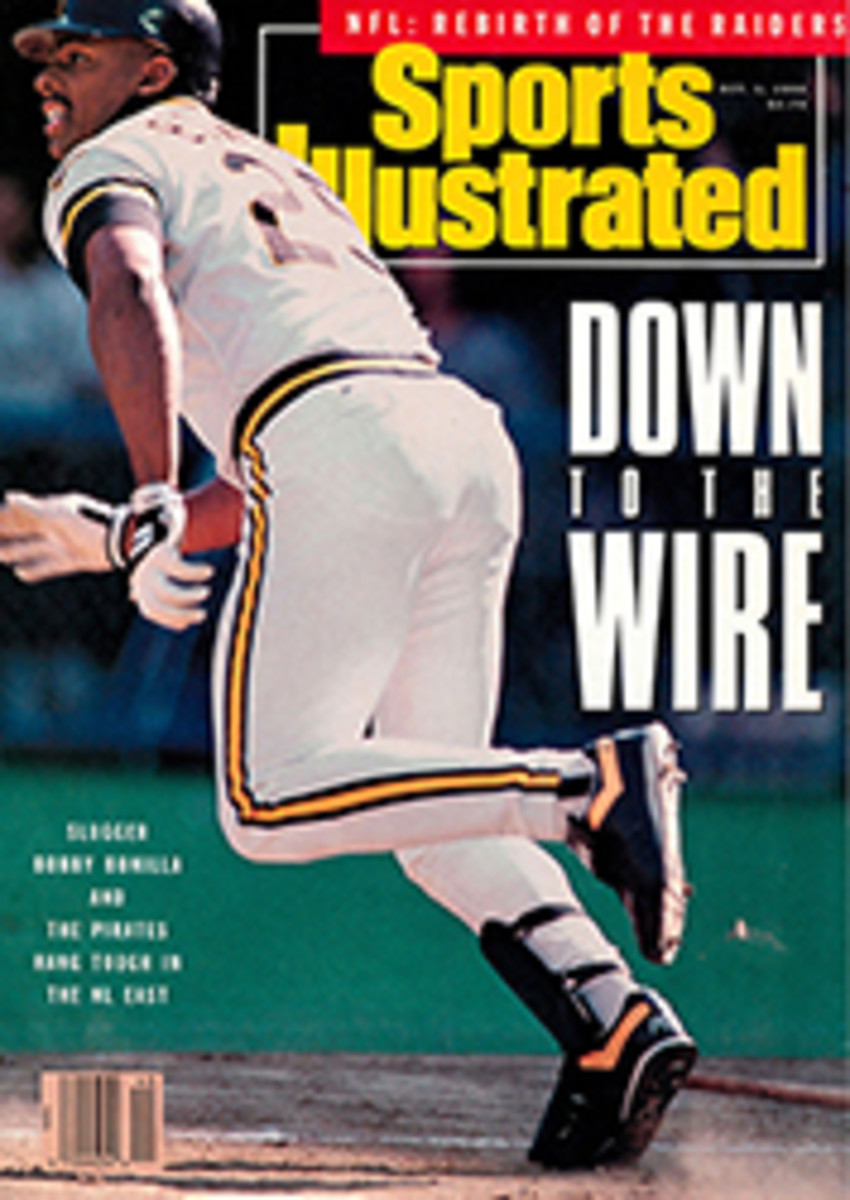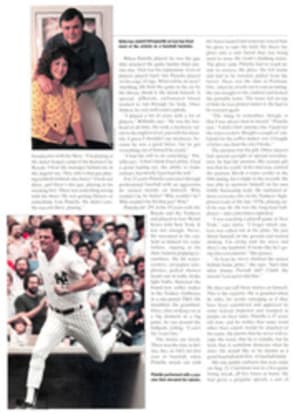
MEET THE HOUDINI OF HANDBALL
Even before he reached the finals of the 40th U.S. Handball Association (USHA) national pro championships, in Atlanta last June, 35-year-old Naty Alvarado had revolutionized the rally-oriented game with his shoot-to-kill style off either hand. In the process, he had earned wide acclaim as the best player ever to strap on a pair of gloves. Like a menacing pistolero in a Clint Eastwood Western, Alvarado entered the Atlanta Sporting Club with his skilled palms itching and vengeance on his mind.
In the semifinals of the '89 tournament, he had lost to Poncho Monreal, his 26-year-old protègè, thus ending a streak of seven straight U.S. four-wall titles. At the awards banquet after that tournament, the chummy handball set gave Alvarado a standing ovation and urged him to speak. He walked up to the dais and spoke softly to the crowd. Bob Peters, the executive director of the USHA, repeated the message for all to hear: "Naty said to tell you, 'It's not over yet.' "
"I don't know how many days after that I cried and thought, How can this happen?" recalls Alvarado, who grew up in poverty in Juarez, Mexico, and learned the sport hustling bets for his father on two courts with warped floors and crooked walls at the neighborhood bathhouse. "If you didn't have anything to play for, you didn't play," says Alvarado. "So there was always something on the line."
As soon as his tears subsided, he began a rigorous training regimen aimed at regaining the U.S. title. He put himself in the hands of Dr. Van Toogood of Victorville, Calif., who started him on a strict nondairy diet and designed his workouts so he would peak at the national tournament. After each match in Atlanta, the 5'11", 172-pound Alvarado would lie on a table while a corps of sports trainers wrapped his limbs, mummy-style, in long strips of thin rubber to ease his soreness and then encased his upper body in ice packs. Clearly, more was at stake for Alvarado than the $3,500 first prize. "The wanting-to," Alvarado declared with a fixed stare after vanquishing top-seeded John Bike, 24, in the semifinals 21-11, 21-12. "That's what I have."
Alvarado's opponent in the title game was Jon Kendler, who had ousted Monreal in the semis 21-9, 21-9. A 6'3", 185-pound lefthander, Kendler, 27, had plenty of "the wanting-to" as well; he had lost in the finals the last two years. Kendler has tried to emulate Alvarado, whose reservoir of devilishly spinning shots and shrewd gamesmanship typically send his opponents ricocheting around the 20' x 40' court. "You fall into Naty's traps more often than he falls into yours," said Kendler, who makes his living leasing commercial real estate in Concord, Calif. "We call him Houdini, because you can never pin him down."
That quality also developed in the years before Alvarado obtained his green card, the document that gives non-U.S. citizens permanent resident status. In 1976, he came to the U.S. from Mexico seeking fame and, for him, fortune, though the paltry purses of the pro handball tour would hardly qualify as bonanzas to most pro athletes. As a 20-year-old in his first tournament, in Tucson, he defeated Fred Lewis, the No. 1 seed, in the semifinals and went on to win the top prize of $1,200. (Even now, prize money alone can't support the dozen or so touring pros who compete at six stops across the U.S., for a total of $150,000.)
In 1979, Alvarado settled in Hesperia, Calif., near Victorville, with his wife, Lupe, and their two children, Naty Jr., now age 17, and Lupe, now 18. He continued to refine his game, and over the next decade he dominated the pro handball circuit, averaging between $40,000 and $50,000 a year from prize money, exhibitions, sponsors and endorsements. In 1982 he began selling life insurance for Equitable of Iowa, which provided some financial security apart from handball, and the next year a third child was born.
The snag in this American dream was that Alvarado had entered the U.S. illegally and had never applied for permanent resident status. "I had nightmares all the time," he says. "The border patrol chasing me, people asking me for my papers. Every time I got on a plane, I worried so much." Once, in 1982, he spent five days in a Seattle jail after being turned away at the Canadian border while on his way to a handball tournament. He was eventually deported to Mexicali, but sneaked back into California a few days later. When he wanted to make a round-trip visit to Mexico, he would print up a phony invitation to a handball tournament in the U.S. and mail it to himself in care of Los Baños Romas, the Juarez bathhouse. Then, when crossing back into the States, he would present the formal-looking invitation to U.S. border officials as his reason for entry.
That all changed in May of 1987, when the U.S. government announced a yearlong amnesty program that would eventually lead to permanent resident status for thousands of illegal aliens. Naty, Lupe and their two oldest children were quick to apply for their green cards (Adriana, now 7, born in the U.S., is a citizen). A year later Alvarado won his record 10th national championship, surpassing the mark held by Joe Platak, who held the title from 1935 through '43 and again in 1945.
Then came Alvarado's defeat in '89, and the confused feelings that eventually spurred him toward Atlanta. "This last year I even thought about not playing, because it hurts inside, it hurts so bad," he said the day before the final. "But that's why I worked so hard. I don't want to retire. I want to do my best so I don't have to worry about it later on."
Handball players talk about the game getting in their blood, coursing through their veins for a lifetime. In Kendler's case, this is especially true. His grandfather, Bob Kendler, founded the USHA in 1951 after deciding the AAU was not adequately promoting the sport. A driven and prickly man, Bob Kendler at one time had employed almost every top U.S. handball player, in his Skokie, Ill., real estate empire, before he went bankrupt in 1980. He saw his grandson play one pro tournament before he died in 1982.
Recent surveys show that 10.5 million Americans play racquetball, compared with two million who play handball, despite the fact that racquetball is a relatively new game—it was invented here in 1949—while handball was imported from Ireland in the mid-1800s. Because handball requires ambidexterity, it is difficult to master; because the rubber ball is hard, it is painful to learn. To close the gap, the USHA has recently introduced a softer ball on which to wean new players. "The people who play with the harder ball are the people who want a challenge," says Carl Porter Jr., the 56-year-old president of the 10,000-member USHA. "Compared to racquetball, we think we have the more demanding game."
The striking motion in handball is a cross between a second baseman's snap throw to first and a boxer's punch. While Alvarado is mainly a righty and Jon Kendler a lefty, each can smack a winning kill shot with his "off" hand from deep in the court, a vast change from the old "sword-and-shield" days when a player only gambled on a winner with his strong hand at short range. Because Kendler's left elbow ached from the combat of a pro stop last March, he began his finals match by serving with his right. That gave Alvarado a slight advantage, which he quickly exploited, driving shots into every nook and corner along the bottom of the front wall. Kendler covered the court with surprising quickness for his gangly frame but eventually succumbed 21-17 in the first game.
Kendler went back to his southpaw serve for the second game. He rushed out to a 12-1 lead and, before Houdini could concoct an escape, triumphed 21-11. That set set up an 11-point tiebreaker.
Alvarado is considered by many to be the best server of all time. By striking the ball from the bottom he can impart spin to make the ball bounce left (known as a "natural"), or by hitting it on top he can make it rebound right (a "reverse") off the front wall. Trailing 5-6 in the tiebreaker, Alvarado tore off three service winners. Then, for the first time in the match, he launched a "Z-serve"—one that strikes the front wall, then the left sidewall and zings back into the right corner. That made it 9-6. Kendler scored again, but Alvarado followed with another "Z" to lead 10-7. He served an unreturnable winner for the victory, and screamed in triumph.
Alvarado, whose nickname is el Gato, the Cat, shook his opponent's hand and punctuated his conquest by springing from the floor onto the front wall. Naty Jr., who had won the 17-and-under division, fell into his father's sweaty hug. "I could see it in his eyes when it was 10-7 that he was going to do it," said Naty Jr. "It was like seeing victory."
The eyes of Naty Sr. would gleam later as he thought of how high he had leaped against the wall after the victory. "I got so far up, I thought, What am I doing way up here?" he said. But as the rest of the handball elite stomped and shouted "Viva, el Gato!" it was clear that up there was where Naty Alvarado belonged.
PHOTO
MANNY RUBIO
Alvarado focused all his training on regaining the national title in Atlanta.
PHOTO
MANNY RUBIO
Kendler played in, and lost, his third straight championship final.
PHOTO
MANNY RUBIO
Naty Jr. hugged his father and fellow champion after Naty Sr.'s victory.

